Azole antifungals and statins can dangerously interact, increasing the risk of severe muscle damage and liver stress. Learn which statins are safest, how to avoid complications, and what alternatives exist in 2025.
Statins: How They Work and How to Use Them Safely
Statins are one of the most common drugs doctors use to lower LDL (bad) cholesterol and cut the risk of heart attack and stroke. If your doctor suggested a statin, you probably want straight answers: what it does, what can go wrong, and simple steps to get the benefit without surprises. This page gives clear, practical info so you can talk to your provider with confidence.
How statins work
Statins block an enzyme in the liver that helps make cholesterol. The result: your liver makes less LDL and takes more LDL out of the blood. Names you’ll hear often are atorvastatin, simvastatin, rosuvastatin, and pravastatin. Some are stronger at lowering LDL than others—your doctor picks the right one based on your cholesterol numbers and overall risk.
Most people take statins to lower long-term risk of heart disease, not to relieve symptoms. That means you might not feel any immediate change, but the drug can reduce the chance of a heart attack or stroke over years.
Practical tips, side effects, and monitoring
Start with a baseline: your provider should check a lipid panel and ask about liver disease, muscle problems, and other medicines. A common plan is a lipid check 4–12 weeks after starting or changing dose, then every 3–12 months once things are stable.
Common side effects include muscle aches, mild digestive issues, and fatigue. Serious muscle damage (rhabdomyolysis) is rare. If you notice severe muscle pain, dark urine, or weakness, get medical help. Statins can slightly raise blood sugar in some people—if you have diabetes risk factors, your doctor will watch that too.
Watch drug interactions. Some antibiotics and antifungals (for example, clarithromycin or itraconazole), certain HIV drugs, cyclosporine, and gemfibrozil can raise statin levels and increase side effect risk. Grapefruit juice can affect some statins (notably simvastatin). Always tell your provider about all prescription and over-the-counter meds, plus herbal products.
Timing matters for some types: simvastatin and pravastatin are often taken at night; atorvastatin and rosuvastatin are flexible. If you miss a dose, don’t double up—take it when you remember unless it’s almost time for the next dose, then skip the missed one.
Pregnancy and breastfeeding are clear no-nos for statins. If you’re pregnant or planning pregnancy, talk with your doctor about stopping the drug and other ways to manage cholesterol.
Finally, lifestyle changes still matter. A heart-healthy diet, regular exercise, quitting smoking, and maintaining a healthy weight add to what statins do. If you have side effects, your doctor can try a lower dose, switch to a different statin, or suggest alternate schedules so you can keep the protection.
If you’re thinking about buying statins online, make sure the pharmacy is licensed and asks for a prescription. When in doubt, ask your healthcare provider before starting or changing any medication.
 21
Nov
21
Nov
 23
May
23
May
Dive into the facts about Lipitor, one of the world's most popular cholesterol-lowering medications. Learn about how it works, what side effects to watch out for, and practical tips for getting the most out of your prescription. This article unpacks the real impact Lipitor has on heart health, with plenty of specifics, data, and advice based on real-life experience. Get the kind of honest and helpful perspective you can't find in a pharmacy leaflet. Find out what you should really know before starting or during your Lipitor journey.





